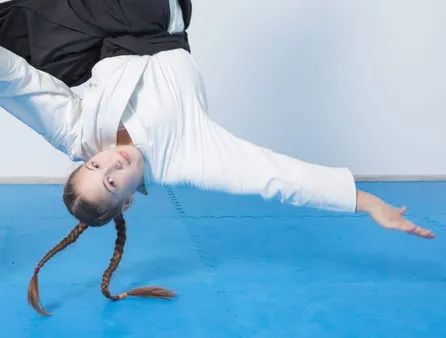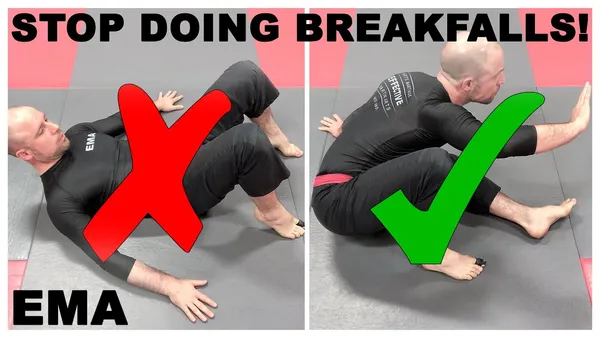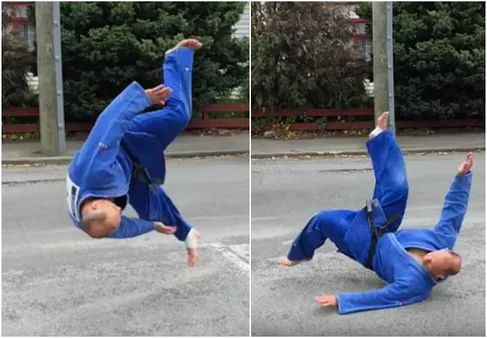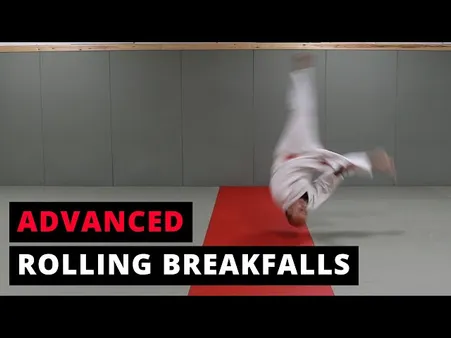Table of Contents
Breakfalls are essential for minimizing injuries from falls, whether you're a seasoned athlete, an outdoor enthusiast, or simply navigating everyday life. Developing proper breakfalling skills can protect you from serious injuries and keep you safe in various situations. Learn the art of breakfalling, identify common mistakes to avoid, and enhance your skills with our comprehensive guide at Kizworld.
How to do a Breakfall: Master the Art of Falling Safely
I. Types of Breakfalls
Types of Breakfalls
Forward Breakfall
A forward breakfall is used to break your fall when you are falling forward. To do a forward breakfall, tuck your chin to your chest, round your back, and spread your arms out in front of you. As you hit the ground, roll onto your shoulder and then your back. Keep your head tucked and your arms out to the sides to protect your head and neck.
- Used to break your fall when you are falling forward.
- Tuck your chin to your chest, round your back, and spread your arms out in front of you.
- As you hit the ground, roll onto your shoulder and then your back. Keep your head tucked and your arms out to the sides to protect your head and neck.
Backward Breakfall
A backward breakfall is used to break your fall when you are falling backward. To do a backward breakfall, tuck your chin to your chest, round your back, and spread your arms out to the sides. As you hit the ground, roll onto your back and then your knees. Keep your head tucked and your arms out to the sides to protect your head and neck.
- Used to break your fall when you are falling backward.
- Tuck your chin to your chest, round your back, and spread your arms out to the sides.
- As you hit the ground, roll onto your back and then your knees. Keep your head tucked and your arms out to the sides to protect your head and neck.
Side Breakfall
A side breakfall is used to break your fall when you are falling to the side. To do a side breakfall, tuck your chin to your chest, round your back, and tuck your arms into your sides. As you hit the ground, roll onto your hip and then your shoulder. Keep your head tucked and your arms close to your body to protect your head and neck.
- Used to break your fall when you are falling to the side.
- Tuck your chin to your chest, round your back, and tuck your arms into your sides.
- As you hit the ground, roll onto your hip and then your shoulder. Keep your head tucked and your arms close to your body to protect your head and neck.
II. Learning Basic Breakfalls
Learning Basic Breakfalls
Mastering the Art of Safe Landings
Breakfalls are an essential skill for any gymnast, providing a safe and controlled way to land after aerial maneuvers. Whether you're a beginner or an experienced gymnast, learning the basics of breakfalls is crucial for preventing injuries and building confidence on the mats. In this section, we'll delve into the fundamentals of breakfalls, helping you master the art of safe landings.
To learn more about the benefits of gymnastics for kids, check out our comprehensive guide: The Benefits of Gymnastics for Kids.
Tuck and Roll: A Beginner's Breakfall
The tuck and roll is a basic breakfall technique that's perfect for beginners. It involves tucking your knees into your chest and rolling forward onto your back. This technique helps absorb the impact of the landing and minimizes the risk of injury. To perform a tuck and roll, follow these steps:
- Start in a standing position with your feet shoulder-width apart.
- Bend your knees and tuck your chin to your chest.
- Roll forward onto your back, keeping your knees tucked in.
- Extend your arms and legs as you roll, absorbing the impact with your entire body.
- Finish the roll by coming to a sitting position.
For more information on how to improve your flexibility and mobility with gymnastics, visit our detailed guide: How to Improve Your Flexibility and Mobility with Gymnastics.
Forward Roll: Advancing Your Breakfall Skills
Once you've mastered the tuck and roll, you can progress to the forward roll. This technique is similar to the tuck and roll, but it involves extending your legs and rolling forward in a continuous motion. The forward roll provides a more controlled landing and helps you maintain your momentum. To perform a forward roll, follow these steps:
- Start in a standing position with your feet shoulder-width apart.
- Bend your knees and tuck your chin to your chest.
- Roll forward onto your back, extending your legs as you roll.
- Keep your arms extended and your body tight as you roll.
- Finish the roll by coming to a standing position.
To learn more about the history and evolution of gymnastics, check out our comprehensive article: The History and Evolution of Gymnastics.
Side Roll: Enhancing Your Breakfall Repertoire
The side roll is a more advanced breakfall technique that allows you to land safely from a sideways fall. This technique is particularly useful for avoiding injuries to your head and neck. To perform a side roll, follow these steps:
- Start in a standing position with your feet shoulder-width apart.
- Bend your knees and tuck your chin to your chest.
- Roll to one side, keeping your knees tucked in and your arms extended.
- Continue rolling until you come to a sitting position.
For more information on how to choose the right gymnastics leotard, visit our detailed guide: How to Choose the Right Gymnastics Leotard.
Conclusion: Safe Landings and Confident Gymnastics
Mastering basic breakfalls is a fundamental step in your gymnastics journey. By practicing these techniques regularly, you'll develop the skills and confidence needed to safely navigate the mats and perform more advanced maneuvers. Remember to start with the tuck and roll, progress to the forward roll, and eventually incorporate the side roll into your breakfall repertoire. With dedication and practice, you'll be able to land safely and confidently, unlocking new possibilities in your gymnastics training.
To learn more about the most common gymnastics injuries and how to prevent them, check out our comprehensive guide: The Most Common Gymnastics Injuries and How to Prevent Them.
III. Breakfalls in Specific Situations
Breakfalls in Specific Situations
Breakfalls are an essential skill for any gymnast, and they can be used in a variety of situations. Here are a few examples of how breakfalls can be used in specific situations:
- When landing from a jump: Breakfalls can help to absorb the impact of a landing and prevent injuries.
- When falling from a height: Breakfalls can help to slow down the fall and reduce the risk of serious injury.
- When being thrown or tackled: Breakfalls can help to protect the body from being injured by the impact of the fall.
There are a few different types of breakfalls, each of which is designed for a specific situation. The most common type of breakfall is the forward roll. The forward roll is used to break a fall from a standing or running position. To perform a forward roll, start by bending your knees and tucking your chin to your chest. Then, roll forward over your shoulder, keeping your back straight and your arms tucked in. As you roll, tuck your knees to your chest and land on your feet.
Another common type of breakfall is the backward roll. The backward roll is used to break a fall from a standing or running position. To perform a backward roll, start by bending your knees and tucking your chin to your chest. Then, roll backward over your shoulder, keeping your back straight and your arms tucked in. As you roll, tuck your knees to your chest and land on your feet.
The side roll is a breakfall that is used to break a fall from a standing or running position. To perform a side roll, start by bending your knees and tucking your chin to your chest. Then, roll to the side over your shoulder, keeping your back straight and your arms tucked in. As you roll, tuck your knees to your chest and land on your feet.
Breakfalls are an essential skill for any gymnast, and they can be used in a variety of situations. By practicing breakfalls regularly, gymnasts can learn to protect themselves from injury and improve their overall performance.
Situation | Type of Breakfall |
Landing from a jump | Forward roll |
Falling from a height | Backward roll |
Being thrown or tackled | Side roll |
In addition to the basic breakfalls described above, there are also a number of other breakfalls that can be used in specific situations. For example, the somersault breakfall is used to break a fall from a high height, while the cartwheel breakfall is used to break a fall from a running position. Gymnasts should learn a variety of breakfalls so that they can be prepared for any situation.
Breakfalls are an essential skill for any gymnast, and they can be used in a variety of situations. By practicing breakfalls regularly, gymnasts can learn to protect themselves from injury and improve their overall performance.
Here are some additional tips for performing breakfalls:
- Start by practicing breakfalls on a soft surface, such as a mat or a grassy field.
- Once you have mastered the basic breakfalls, you can start practicing them on harder surfaces, such as concrete or asphalt.
- Be sure to wear proper safety gear, such as a helmet and knee pads, when practicing breakfalls.
- Practice breakfalls regularly so that you can become proficient in them.
By following these tips, you can learn to perform breakfalls safely and effectively.
Breakfalls are an essential skill for any gymnast, and they can be used in a variety of situations. By practicing breakfalls regularly, gymnasts can learn to protect themselves from injury and improve their overall performance.
If you are interested in learning more about breakfalls, there are a number of resources available online and in libraries. You can also find breakfalls classes at most gymnastics gyms.
With a little practice, you can learn to perform breakfalls safely and effectively. So what are you waiting for? Start practicing today!
Here are some related articles that you may find helpful:
IV. Common Mistakes and Safety Tips
Common Mistakes and Safety Tips
Despite its exciting nature, breakfalling also comes with a set of inherent risks and potential hazards. Hence, it's crucial to be aware of common mistakes and prioritize safety to avoid any injuries or accidents while practicing this technique. Here, we present some prevalent mistakes to watch out for and essential safety measures to keep in mind during your breakfall training:
- Neglecting Proper Warm-up: Skipping or rushing your warm-up can increase the risk of muscle strains or tears. Always begin with dynamic stretches and light exercises to prepare your body for the more intense breakfall movements.
- Improper Landing Technique: Failing to distribute your weight evenly or landing with excessive force can lead to impact injuries. Focus on maintaining a balanced landing with your weight distributed across your entire body, absorbing the impact through your legs and core muscles.
- Lack of Spotting: Practicing breakfalls without a competent spotter can increase the likelihood of severe injuries, especially for beginners. Ensure that you have an experienced spotter who can guide and assist you throughout your training. Read the related article How to Choose the right martial art for you?
- Ignoring the Importance of Practice: Mastery in breakfalling comes with consistent practice. Allocate sufficient time for regular training sessions to hone your skills and improve your muscle memory. Remember, repetition is key to becoming proficient in breakfalls.
- Training on Unsuitable Surfaces: Using inappropriate or slippery surfaces can increase the risk of uncontrolled falls or injuries. Choose a safe training area with a mat or a soft surface that provides adequate cushioning to minimize impact.
Apart from these mistakes, there are several safety tips that can help you stay protected while practicing breakfalls:
- Listen to Your Body: Pay attention to any signs of pain or discomfort during training. Pushing yourself too hard can lead to injuries. Take breaks when necessary and avoid overexerting yourself.
- Stay Hydrated: Maintaining proper hydration is crucial for optimal performance and injury prevention. Drink water regularly before, during, and after your training sessions.
- Wear Appropriate Attire: Choose comfortable and form-fitting clothing that allows for unrestricted movement and adequate protection. Avoid loose clothing that might get caught or hinder your breakfalls.
- Perform Regular Strength and Conditioning Exercises: Building strength and conditioning your body through exercises can enhance your overall fitness and reduce the risk of injuries during breakfalls.
- Seek Professional Guidance: If you're new to breakfalls or have any specific concerns, consider seeking guidance from a qualified instructor or coach. They can provide personalized advice and supervision to help you progress safely.
V. Conclusion: The Power of Engaging, Beneficial, and Easy-to-Read Content
In the realm of content creation, the pursuit of engaging, beneficial, and easy-to-read content stands as a cornerstone of success. By understanding your audience, crafting clear and concise sentences, structuring your content effectively, and incorporating storytelling and visuals, you can create content that captivates, informs, and resonates with your readers. Remember, the key to content mastery lies in authenticity, passion, and a commitment to excellence. Embrace these principles, and you will create content that leaves a lasting impact on your audience and achieves your content marketing goals.